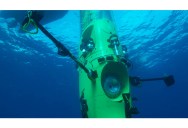Everything You Need to Know About James Cameron and the Deep Sea Challenge

On Sunday March 25, 2012 at noon, local time (10 p.m. ET), James Cameron’s vertical torpedo sub, the ‘Deep Sea Challenger’, broke the surface of the western Pacific, carrying the National Geographic explorer and filmmaker back from the Mariana Trench’s Challenger Deep. It is Earth’s deepest, and perhaps most alien, realm.
After a 70-minute descent, he became the first human to reach the 6.8-mile-deep (11-kilometer-deep) undersea valley solo, arriving at the bottom with the technology to collect scientific data, specimens, and visions unthinkable in 1960, when the only other manned Challenger Deep dive took place. Cameron spent hours hovering over Challenger Deep’s desert-like seafloor and gliding along its cliff walls, the whole time collecting samples and video.
Below you will find a summary of information about this incredible expedition, the Mariana Trench and the Deep Sea Challenger submersible. For complete information and all of the latest updates, please visit the official page at deepseachallenge.com

The Deep Sea Challenge Expedition
“I’ve always dreamed of diving to the deepest place in the oceans. For me it went from a boyhood fantasy to a real quest, like climbing Everest, as I learned more about deep-ocean exploration and became an explorer myself in real life. This quest was not driven by the need to set records, but by the same force that drives all science and exploration … curiosity.
So little is known about these deep places that I knew I would see things no human has ever seen. There is currently no submersible on Earth capable of diving to the ‘full ocean depth’ of 36,000 feet. The only way to make my dream a reality was to build a new vehicle unlike any in current existence.
Our success during seven prior expeditions building and operating our own deep-ocean vehicles, cameras, and lighting systems gave me confidence that such a vehicle could be built, and not just with the vast resources of government programs, but also with a small entrepreneurial team. It took more than seven years to design and build the vehicle, and it is still a work in progress. Every dive teaches us more, and we are continuing to improve the sub and its systems daily, as we move through our sea trials.” — James Cameron

– More than 50 years ago, two men climbed into a massive, blimp-like submersible, descended about 35,800 feet (10,912 meters) to the deepest point in the ocean, and became the first people to observe the dark underworld of one of Earth’s most extreme environments. No one has been back since
– James Cameron, a National Geographic explorer-in-residence, plans to take multiple dives to this point, known as the Challenger Deep in the Mariana Trench, in a custom-built submersible that he co-designed with Ron Allum
– Although best known for directing films such as Titanic and Avatar, Cameron is an avid explorer with 72 submersible dives to his credit—51 of which were in Russian Mir submersibles to depths of up to 16,000 feet (4,877 meters), including 33 to Titanic
– In recent years, deep-ocean dredges and unmanned subs have glimpsed exotic organisms such as shrimp-like amphipods, and strange, translucent animals called holothurians. But scientists say there are many new species awaiting discovery and many unanswered questions about how animals can survive in these extreme conditions. Scientists are particularly interested in microorganisms living in the trenches, which they say could lead to breakthroughs in biomedicine and biotechnology
[SOURCE]

The Mariana Trench
– While thousands of climbers have successfully scaled Mount Everest, the highest point on Earth, only three people have descended to the planet’s deepest point, the Challenger Deep in the Pacific Ocean’s Mariana Trench.
– In 1960, Jacques Piccard and Navy Lt. Don Walsh reached this goal in a U.S. Navy submersible, a bathyscaphe called the Trieste. After a five-hour descent, the pair spent only a scant 20 minutes at the bottom and were unable to take any photographs due to clouds of silt stirred up by their passage
– Located in the western Pacific east of the Philippines and an average of approximately 124 miles (200 kilometers) east of the Mariana Islands, the Mariana Trench is a crescent-shaped scar in the Earth’s crust that measures more than 1,500 miles (2,550 kilometers) long and 43 miles (69 kilometers) wide on average
– The distance between the surface of the ocean and the trench’s deepest point—the Challenger Deep, which lies 62 miles (100 kilometers) southwest of the U.S. territory of Guam—is nearly 7 miles (11 kilometers). If Mount Everest were dropped into the Mariana Trench, its peak would still be more than a mile (1.6 kilometers) underwater
– The Mariana Trench is part of a global network of deep troughs that cut across the ocean floor. They form when two tectonic plates collide. At the collision point, one of the plates dives beneath the other into the Earth’s mantle, creating an ocean trench
– Because of its extreme depth, the Mariana Trench is cloaked in perpetual darkness and the temperature is just a few degrees above freezing. The water pressure at the bottom of the trench is a crushing eight tons per square inch—or about a thousand times the standard atmospheric pressure at sea level
– The majority of the Mariana Trench is now a U.S. protected zone as part of the Marianas Trench Marine National Monument, established by President George W. Bush in 2009. Permits for research in the monument, including in the Sirena Deep, have been secured from the U.S. Fish and Wildlife Service. Permits for research in the Challenger Deep have been secured from the Federated States of Micronesia.
[SOURCE]
The Deep Sea Challenger Torpedo Sub

– A sleek, narrow, 24-foot-tall (7.3-meter) vessel, the DEEPSEA CHALLENGER has three main sections. The beam, the biggest single component, is made of a new kind of foam that provides both flotation and a strong structural core. The pilot sphere is slung below the beam, and below that an array of scientific gear stands ready to deploy at the bottom
– About 70 percent of the sub’s volume is taken up by syntactic foam. Formed of millions of hollow glass microspheres suspended in an epoxy resin, syntactic foam is the only flotation material that can stand up to the incredible pressures in the deep ocean
– The pilot is descending about 36,000 feet (10,973 meters), but his ears won’t pop during the journey; the pressure inside the pilot’s sphere stays constant. The submersible will spin slowly as it descends and ascends. It’s engineered to do this so it doesn’t veer off track
– The sub will descend because of more than 1,000 pounds (450 kilograms) of steel weights held on to either side by electromagnets. To rise to the surface, the pilot will flip a switch, the plates of steel will fall to the ocean floor, and the lighter-than-water foam will hurtle the sub skyward.
[SOURCE]

– The pilots will rely entirely on battery power during their dives. In fact, the sub has enough batteries to power two or three modern electric cars. Most of the stored energy is contained in about 70 bread-loaf-size battery packs inside oil-filled plastic boxes mounted into the sub’s sides
– The sub’s batteries are made up of over a thousand pouch-type lithium-ion cells, bigger versions of the batteries hobbyists use for model airplanes.
– More than 180 systems—from battery packs to sonar—will be operating during the dive
– Just like a car, the sub is equipped with “cruise control” so the pilot can hover exactly where he wants to or glide through the water at a constant speed.
– Once on the bottom, the lone pilot will use joysticks to command 12 thrusters to propel the sub along the ocean floor. The thrusters will allow him to move forward at 3 knots, as well as vertically at 2.5 knots
– At the push of a button, the control system can keep the sub at a set level above the seafloor. This is called Auto Altitude. Another function is just like the cruise control on a car: The pilot pushes the “cruise” button when he has set his forward speed, and the sub stays at that speed for as long as required
[SOURCE]



– Crammed with equipment and just 43 inches (109 centimeters) wide, the interior of the pilot sphere is so small that the pilot will have to keep his knees bent and can barely move
– The pilot chamber is a sphere because it’s the strongest shape for resisting pressure—if the pilot sat in a cylinder, the walls would need to be three times thicker
– A touch screen next to the “virtual viewport” helps him monitor everything from battery power to oxygen levels. The interior also includes food, water, and joysticks connected to the “thrusters,” essentially motors that help the sub move horizontally and vertically
– The sub is equipped with two compressed oxygen cylinders, which contain enough O2 to keep the pilot breathing for up to 56 hours—seven times the amount of time he expects to spend diving the Challenger Deep
– Water vapor from the pilot’s breath and sweat condenses on the cold metal sphere and drains to a space where it’s sucked into a plastic bag. In an emergency, the pilot can drink it
[SOURCE]



– The sub’s four external cameras are a tenth the size of previous deep-ocean HD cameras. The housings were designed by the DEEPSEA CHALLENGE team, and the cameras themselves were created from scratch, from the sensor up
– The sub will illuminate the ocean with an eight-foot (two-meter) panel of LED lights. Cameron will likely be able to see for about 100 feet (30 meters), but clouds of sediment could obscure his view
– Inches from the pilot’s face a screen projects images captured by a Red Epic 5K camera that generates a wide-angle view—better than what the pilot could see with his eyes
– When the pilot encounters something he’d like to collect or examine, a hydraulic arm will emerge from the payload bay. Controlled by a joystick, it’s a real-life version of the mechanical limbs Cameron created for his films Aliens and Avatar
– When filming, the pilot will share the pilot sphere with three cameras. The largest is a Red Epic, which will capture IMAX-quality, “5K-raw” images and will be mounted directly in front of the small viewport on the sphere’s hatch. That window—which from the inside is only about the size of a fist and is just below the pilot’s knees—will be awkward for pilots Cameron or Allum to look through on their own. But the window is cone-shaped and is much larger on the side that faces the ocean’s pressure. The curvature of the window also corrects for the 30-percent magnification that water causes. With the camera attached and its image projected onto a high-definition screen at the pilot’s eye level, he’ll get a wide view of his surroundings through this “virtual viewport.”
– Inside the sphere, two tiny HD cameras (two are needed to create 3-D video) will also film the pilot himself
– Resembling tall, skinny phone booths, landers are unmanned robotic vehicles that descend to the seafloor, perform pre-programmed tasks, and return to the surface. The DEEPSEA CHALLENGE expedition has two landers, each able to dive to the ocean’s greatest depths. Like the submersible, they descend vertically. Dives can last 30 hours, and the landers can be deployed as a kind of “advance party.”
[SOURCE]



If you enjoyed this post, the Sifter highly recommends:

Sign up to get our BEST stories of the week straight to your inbox.




